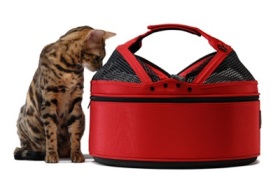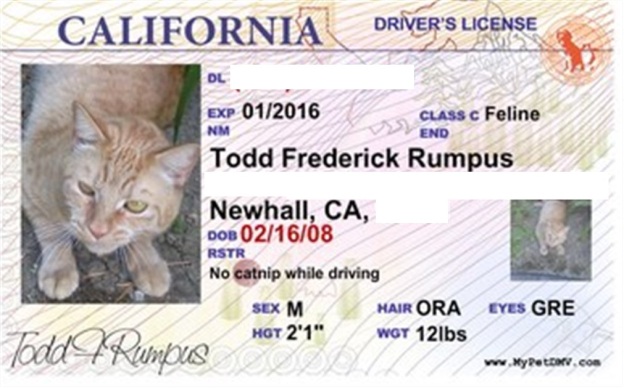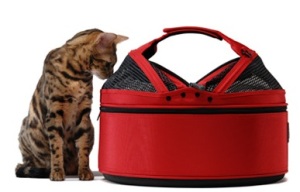
I’m ready to go!
Here’s the last part of my installment for travelling with cats …. or, in this case, without cats. Sometimes you humans can’t take us cats with you. Sometimes, us cats don’t want to or can’t go. That means leaving us behind. When you can’t take us with you for whatever reason, you have a few options.
First, there’s boarding facilities. You can find all sorts of different kind of boarding facilities from those that use cages, those that don’t use cages, those that house both dogs and cats, and those at Veterinary Hospitals. The good part about using a veterinary hospital is that if we should get sick, they’re more likely to spot it sooner and react quicker. The down side is that Veterinary Hospitals tend to be short on space, short on time, and tend to use cages. What’s wrong with cages, you ask? Just think of what it would be like for you to go to jail for the holidays. Not exactly you’re idea of a merry time!!! However, not all Veterinary Hospitals use cages, and there are more of them trying to make cat boarding as comfortable as possible for us cats. The Purr-fect Hotel at the Highland Veterinary Hospital in Highland, MD is a great example of a hospital that has some great space for boarding cats. I’d be pretty comfy there!
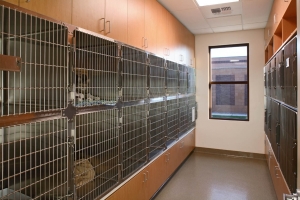
Standard Cat Boarding Cages
Additionally, for some interesting, strange, unidentifiable reason, most boarding facilities that use cages tend to have the cages facing each other (Veterinary Hospitals are typically the exception to this rule, but not always). So, what’s wrong with this, you ask? Well, I’m a social guy; I like other kitties. But if there’s a cat on the other side of the room staring me down because he hates other cats, it doesn’t exactly make my stay very comfortable. In fact, it stresses me out big time. And for that cat who doesn’t like other cats, being at a boarding facility that uses cages will be incredibly miserable for him, incredibly stressful, and make him more susceptible to illness (travel, which stresses us out, will always make us more susceptible to illness, but we’re talking about the difference between possibly getting a little cough to coming down with a full-blown cold). So, in your search for boarding facilities, try not to choose one that has cages … and try not to pick that one that says it houses cats in cages in a cozy laundry room (I kid you not!). You may pay a little bit more for a cageless boarding facility, but generally the difference in cost is minor.
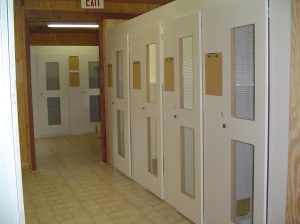
A view of Camp Kitty
So what else should you look for? Try to stay away from boarding facilities that house both dogs and cats. There are cat-only boarding facilities out there. But if you can’t find one near you, try to choose a facility where the dog noise is comfortably muffled. Note: if there are dogs housed at the boarding facility, you won’t be able to get away from dog noise. Also ask to go on a tour of the facility. If they won’t let you, don’t board your cat there. And if there is more than a minimal smell of litter or food (similar to what you’d smell at home), don’t use that facility, either (do keep in mind that if they’ve just cleaned, which is typically done during the morning hours, there may be a stronger odor than if they’d cleaned hours ago). Also ask what veterinarian they use (if you’re not boarding at a Veterinary Hospital). If they don’t freely give you that information, go away. Also, if they don’t allow you to bring bedding, toys and food from home, they probably don’t understand how to make a cat as comfortable as possible (would you want to go somewhere that you weren’t allowed to bring your own clothes and had to wear someone else’s?). And do be sure to bring some comforts from home; it makes us feel a lot better! Know that most, if not all, boarding facilities require that your cat is current on vaccines. If your vet has recommended not giving anymore vaccines (which can happen, especially if the cat is older), talk with them about doing so for boarding purposes or if there are any other alternatives.
A really good example of a cat boarding facility is called Evergreen Cat Lodge in Evergreen, CO. You can house up to 3 cats in one suite for no extra charge (a lot of places do charge extra for more than one cat). The rooms look like little homes. And they don’t charge for little add-on services like nail clippings, administering medications, and ATTENTION!!! The only extra service charges, which is optional, that they appear to have are webcams that you can gain access to for $5 per day. And, let’s face it, that’s a really minimal charge for the pleasure of watching your cats nap all day!!! There’s also the Cat Taxi in the off-chance you can’t bring us yourself. The price of the cat taxi is similar to how an actual taxi works (they charge by mile with a $20 minimum charge).

Feline Wishes and Caviar Dreams
Some other good examples of cat boarding facilities are Feline Wishes and Caviar Dreams in San Francisco, CA and Camp Kitty in Scottsdale, GA. Please be aware that I’ve never been to a boarding facility, so I am not advertising for nor vouching for any of these places. I’m calling them good solely from what information I find online. It’s up to you to choose what you’re comfortable with.
However, in most cases, when you have to leave your kitty behind, using a pet sitter is typically the best option. We’ll be at home where we can hide in our usual spots, smell the usual smells, and not have to worry about going anywhere. How do you find a petsitter? First, find one who specializes in cats. It doesn’t have to be a cat-only pet sitter, but s/he should know cats well, appear comfortable around your cats, and have some good knowledge of cat behavior. Some pet sitters are insured, some are not. Which do you choose? Well, pet sitters that are insured are typically insured to cover mishaps, such as damage to the home (whether the sitter is in the home at the time or not) and sudden illnesses of your cats. What does this mean for you? A pet sitter who’s insured is covered during mishaps while an uninsured pet sitter must pay for mishaps out of their own pocket (and aren’t protected in case the client – you – decides to sue for a mishap). It’s up to you whether you choose an insured or uninsured pet sitter. In most cases, it doesn’t make much of a difference.
How do you get recommendations for pet sitters? You can ask your veterinarian, employees of an animal shelter, friends who have cats, or you can do a search online, like through Yelp or Craigslist. Make sure that you’re comfortable with whoever you choose … you are entrusting them with the keys to your home and your cats. Ask questions that are important to you. Maybe you want to know what kind of experience they have with cats, if they’ve ever medicated a cat, if they know how to work with shy cats, what to look for in sick cats, etc.
So, remember that we cats generally prefer to stay at home.
If we can’t stay at home (like we’re old or sick or….), take us to a good boarding facility like this:
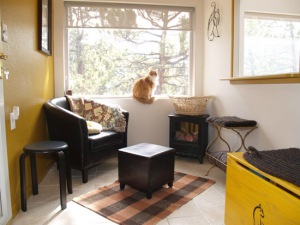
Good Cat Boarding at Evergreen Cat Lodge
Lastly, remember that this is bad:

Bad Cat Boarding
And this is even worse:

Not an actual boarding facility photo.
37.775200
-122.276704
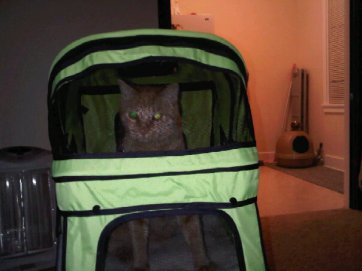 It’s been too long since I last posted. But mom and me have been busy trying to get ready to become a pet-assisted therapy team. Well, I’ve been busy trying to get ready for that. Mom has been busy trying to study for her bachelor’s degree, which she says is real important since that’s what’s going to help her to buy me cat food, peacock feathers, and a house of my own (if I have my own house, then I can have my little sister Penny over only when I feel like inviting her over!!!).
It’s been too long since I last posted. But mom and me have been busy trying to get ready to become a pet-assisted therapy team. Well, I’ve been busy trying to get ready for that. Mom has been busy trying to study for her bachelor’s degree, which she says is real important since that’s what’s going to help her to buy me cat food, peacock feathers, and a house of my own (if I have my own house, then I can have my little sister Penny over only when I feel like inviting her over!!!).

